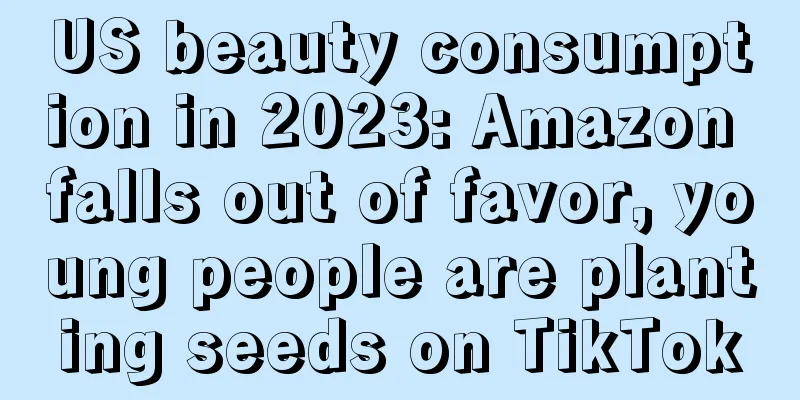US beauty consumption in 2023: Amazon falls out of favor, young people are planting seeds on TikTok

|
It is learned that in May this year, PoweReviews surveyed 26,340 American consumers on the purchasing behavior of beauty and health products, and released the "2023 Health and Beauty Shopping Trends". The report reveals the portraits, purchasing habits and consumption behavior characteristics of American beauty product consumers.
Beauty and health consumption levels rise, Amazon's share declines
According to the survey, American consumers' spending on beauty and health products has increased compared with last year, with the highest proportion of consumers spending between $51 and $100, followed by $101 to $200. The proportion of consumers spending more than $200 reached 29%, significantly higher than last year's 15%. This may be the result of the "lipstick effect".
In the most frequently purchased sub-categories, skin care products (96%), makeup (94%) and bath products (90%) topped the list. For makeup and skin care products, the price range of less than $50 and $50-100 is more popular, with the former being slightly more popular; for bath and body care products, the price range of less than $50 is the most popular.
In addition, when purchasing these common categories, 96% of consumers said they were at least likely to purchase a new product in the same transaction, indicating that consumers are more willing to try new products.
In terms of online shopping habits, the survey shows that the proportion of consumers who spend $1 to $50 per month on beauty and health products is the highest, accounting for 31%, followed by consumers who spend $51 to $100, accounting for 27%. It is worth noting that consumers who spend more than $101 per month account for 37%, higher than last year's 24%.
Among online shoppers, the majority said that 26% to 50% of the beauty products they purchased in the past year were products they had never tried before. 31% said that new products accounted for 51% or more of their online beauty purchases last year.
In terms of purchase channels, professional beauty retailers such as Ulta.com or Sephora.com are the most selected purchase channels. In contrast, Amazon's share in this category continues to decline, with only 17% of people saying that Amazon is the first place they start shopping for health and beauty products. Other channels include brand websites (57%), Amazon (54%) and large retailer websites (such as Target and Walmart).
In terms of product research channels, specialty retailers and brand websites occupy the top two positions, with Amazon ranking third.
UGC content becomes a key factor affecting purchases
The survey shows that beauty product consumers consider many factors when making a purchase decision, and UGC (user-generated content) is the most considered factor. The survey shows that 88% of consumers consider ratings and reviews when making a purchase decision, and 67% consider photos and videos of other consumers.
Social media is an important channel for consumers to learn about beauty products. Instagram is the preferred channel for consumers to learn about new products, followed by TikTok.
There are many types of user-generated content, including review time, review content, etc. The survey shows that when American consumers buy beauty products, they pay most attention to the average star rating of the product, accounting for about 77%. Other factors include the number of reviews (75%), written reviews (74%) and average time progress (60%). According to the survey, almost all consumers read reviews when shopping for beauty products online (99.5%), and consumers who buy products in physical stores also read reviews online (92%), which is a significant increase from last year.
Additionally, many consumers check out Q&A sections when shopping online, and 97% of consumers view other consumers’ photos and videos when shopping online. A recent analysis found that website visitors who interacted with user-generated photos and videos had a 103.9% higher conversion rate.
Other influencing factors include consumer values. The survey shows that the brand's inclusiveness, environmental friendliness and natural ingredients are also important influencing factors.
Young people have higher consumption levels, and TikTok has a greater impact on purchases
The study also examined the differences in spending on beauty and health products among Generation Z, Millennials, Generation X and Baby Boomers.
The survey shows that in terms of monthly spending, the spending of Generation Z and Millennials is mainly concentrated in the three ranges of 50-100, 100-200, and 200-500 US dollars, and the proportion of consumers is relatively even. The spending of Generation X and Baby Boomers is mainly concentrated in the range of 1-50, 50-100, and 100-200 US dollars, and Baby Boomers buy more low-priced goods. Online shopping spending also shows the same characteristics.
In terms of purchase considerations, the top three factors that these four groups value most are buyer reviews, buyer photos and videos, and recommendations from family and friends, but there are obvious differences in the fourth and fifth factors.
For Gen Z, TikTok and in-store recommendations were the fourth and fifth most influential factors, while for Millennials, Instagram and TikTok ranked fourth and fifth, respectively. For Gen X and Baby Boomers, retail websites and in-store recommendations ranked fourth and fifth. Editor✎ Ashley/ Disclaimer: This article is copyrighted and may not be reproduced without permission. |
<<: Amazon Prime Day advertising review, various indicators and data released
Recommend
20 common problems that new Amazon users often encounter when registering an account
Some common sense questions that novice sellers o...
Want to succeed in the red ocean category? You have to rely on this...
It’s the peak sales year for Amazon sellers again...
Can the additional tariffs be avoided this way? ! Official statement
A full month has passed since the United States o...
Walmart launches inventory delivery service for third-party sellers to speed up delivery!
Walmart has begun rolling out a new inventory-cent...
Pinch your own philtrum! Amazon France may face a ban on sales of its products because...
"On Tuesday, local time in the United States...
Jiazhilian falsely inflated its net profit and was warned by the China Securities Regulatory Commission
On August 5, Jiazhilian’s parent company “Xunxing ...
The exchange rate breaks 6.3! The US dollar continues to depreciate. Should sellers raise prices or change their business?
Today is Children's Day, but for the expired c...
What is adSage? AdSage Review
Beijing AdSage Technology Co., Ltd. (AdSage/adSage...
Product selection ideas | To explore Amazon’s new blue ocean in 2021, the key is whether you can select products!
The epidemic has changed consumer demand, and new ...
Starting in 2023! The USPS will adjust rates every January and July!
It is learned that the United States Postal Servic...
I have been in the boutique operation for 6 years and I am ready to go it alone! I would like to ask the seniors who have entered the field to go it alone, how do you acquire a series of necessary process experience?
Anonymous user My C position As a boutique operato...
Etsy's third quarter was strong, but sellers are suffering?
It is learned that on November 2, US time, the Ame...
What is the Libra Association? Libra Association Review
The Libra Association, the governing body behind F...
What is MyMusicTaste? MyMusicTaste Review
MyMusicTaste was founded in 2013 and is a concert ...
The tariff threshold has helped Chinese sellers to attack Amazon! After local businesses were eroded, the United States began to get anxious
Chinese sellers have always been the top players o...









